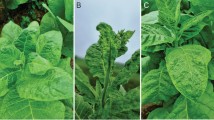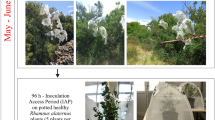Abstract
Ornamental perennial plants may serve as reservoirs for viruses that infect field crops. Duranta repens is an ornamental shrub that frequently exhibits leaf curl symptoms typical of begomoviral infection. Two begomoviruses or DNA-A components (isolates 57SA and 58SA) along with a DNA-B component (31SA) were identified in a symptomatic D. repens plant. Isolates 57SA and 58SA showed the highest nucleotide sequence identity of 90% and 92.2% to catharanthus yellow mosaic virus (CaYMV) and chilli leaf curl India virus (ChiLCINV), respectively, whereas 31SA shared the highest nucleotide sequence identity of 95.2% with the DNA-B component of tomato leaf curl New Delhi Virus (ToLCNDV). Isolate 57SA (showing < 91% highest nucleotide sequence identity) may thus be considered a member of a distinct species, and we propose the name “duranta leaf curl virus” (DLCV) for this virus. In addition, isolate 58SA (showing highest nucleotide sequence identity < 94%) is a newly identified strain of ChiLCINV for which the name “Duranta” strain is proposed. Further analysis showed that 57SA, 58SA and 31SA are recombinant, again highlighting the importance of recombination in begomovirus evolution. This is the first identification of DLCV. Also, a mixed infection with two viruses (or DNA-A components) and one DNA-B is reported.


Similar content being viewed by others
References
Andrade E, Manhani G, Alfenas P, Calegario R, Fontes E, Zerbini F (2006) Tomato yellow spot virus, a tomato-infecting begomovirus from Brazil with a closer relationship to viruses from Sida sp. forms pseudorecombinants with begomoviruses from tomato but not from Sida. J Gen Virol 87:3687–3696
Argüello-Astorga G, Guevara-Gonzalez R, Herrera-Estrella L, Rivera-Bustamante R (1994) Geminivirus replication origins have a group-specific organization of iterative elements: a model for replication. Virology 203:90–100
Argüello-Astorga G, Ruiz-Medrano R (2001) An iteron-related domain is associated to motif 1 in the replication proteins of geminiviruses: identification of potential interacting amino acid-base pairs by a comparative approach. Arch Virol 146:1465–1485
Brown JK, Zerbini FM, Navas-Castillo J, Moriones E, Ramos-Sobrinho R, Silva JC, Fiallo-Olivé E, Briddon RW, Hernández-Zepeda C, Idris A (2015) Revision of begomovirus taxonomy based on pairwise sequence comparisons. Arch Virol 160:1593–1619
Doyle JJ (1990) Isolation of plant DNA from fresh tissue. Focus 12:13–15
Edgar RC (2004) MUSCLE: a multiple sequence alignment method with reduced time and space complexity. BMC Bioinform 5:113
Fontes E, Eagle PA, Sipe PS, Luckow VA, Hanley-Bowdoin L (1994) Interaction between a geminivirus replication protein and origin DNA is essential for viral replication. J Biol Chem 269:8459–8465
Fontes E, Gladfelter HJ, Schaffer RL, Petty I, Hanley-Bowdoin L (1994) Geminivirus replication origins have a modular organization. Plant Cell 6:405–416
Hill JE, Strandberg JO, Hiebert E, Lazarowitz SG (1998) Asymmetric infectivity of pseudorecombinants of Cabbage leaf curl virus and squash leaf curl virus: implications for bipartite geminivirus evolution and movement. Virology 250:283–292
Inoue-Nagata AK, Albuquerque LC, Rocha WB, Nagata T (2004) A simple method for cloning the complete begomovirus genome using the bacteriophage φ29 DNA polymerase. J Virol Methods 116:209–211
Iram S, Amrao L, Mansoor M, Malik A, Briddon R, Zafar Y (2005) First report of a begomovirus associated with leaf curl disease of Duranta erecta in Pakistan. Plant Pathol 54:260
Laufs J, Traut W, Heyraud F, Matzeit V, Rogers SG, Schell J, Gronenborn B (1995) In vitro cleavage and joining at the viral origin of replication by the replication initiator protein of Tomato yellow leaf curl virus. Proc Natl Acad Sci 92:3879–3883
Lazarowitz SG, Shepherd R (1992) Geminiviruses: genome structure and gene function. Crit Rev Plant Sci 11:327–349
Martin DP, Murrell B, Golden M, Khoosal A, Muhire B (2015) RDP4: detection and analysis of recombination patterns in virus genomes. Virus Evol 1:3
Marwal A, Sahu AK, Gaur R (2013) Molecular characterization of a begomovirus infecting a new host Golden Duranta (Duranta erecta) in India. Int J Curr Microbiol Appl Sci 2:45–48
Muhire BM, Varsani A, Martin DP (2014) SDT: a virus classification tool based on pairwise sequence alignment and identity calculation. PLoS One 9:e108277
Mustujab A, Briddon R, Tahir M (2015) First report of Catharanthus yellow mosaic virus infecting Duranta repens in Pakistan. J Plant Pathol 97:210
Rojas MR, Hagen C, Lucas WJ, Gilbertson RL (2005) Exploiting chinks in the plant’s armor: evolution and emergence of geminiviruses. Annu Rev Phytopathol 43:361–394
Roumagnac P, Granier M, Bernardo P, Deshoux M, Ferdinand R, Galzi S, Fernandez E, Julian C, Abt I, Filloux D, Mesleard F, Varsani A, Blanc S, Martin DP, Peterschmitt M (2015) Alfalfa leaf curl virus: an aphid-transmitted geminivirus. J Virol 89:9683–9688
Seal S, VandenBosch F, Jeger M (2006) Factors influencing begomovirus evolution and their increasing global significance: implications for sustainable control. Crit Rev Plant Sci 25:23–46
Shafiq M, Asad S, Zafar Y, Briddon RW, Mansoor S (2010) Pepper leaf curl Lahore virus requires the DNA B component of Tomato leaf curl New Delhi virus to cause leaf curl symptoms. Virol J 7:367
Tahir M, Haider M, Shah A, Rashid N, Saleem F (2006) First report of bipartite begomovirus associated with leaf curl disease of Duranta repens in Pakistan. J Plant Pathol 88:339–342
Tamura K, Peterson D, Peterson N, Stecher G, Nei M, Kumar S (2011) MEGA5: molecular evolutionary genetics analysis using maximum likelihood, evolutionary distance, and maximum parsimony methods. Mol Biol Evol 28:2731–2739
Varsani A, Navas-Castillo J, Moriones E, Hernández-Zepeda C, Idris A, Brown JK, Zerbini FM, Martin DP (2014) Establishment of three new genera in the family Geminiviridae: Becurtovirus, Eragrovirus and Turncurtovirus. Arch Virol 159:2193–2203
Varsani A, Roumagnac P, Fuchs M, Navas-Castillo J, Moriones E, Idris A, Briddon RW, Rivera-Bustamante R, Zerbini FM, Martin DP (2017) Capulavirus and Grablovirus: two new genera in the family Geminiviridae. Arch Virol 162:1819–1831
Venkataravanappa V, Reddy CL, Jalali S, Reddy MK (2015) Association of Tomato leaf curl New Delhi virus DNA-B with Bhendi yellow vein mosaic virus in okra showing yellow vein mosaic disease symptoms. Acta Virol 59:125–139
Zaidi S, Iqbal Z, Amin I, Mansoor S (2015) First report of Tomato leaf curl Gujarat virus, a bipartite begomovirus on cotton showing leaf curl symptoms in Pakistan. Plant Dis 99:1655
Zhang W, Olson NH, Baker TS, Faulkner L, Agbandje-McKenna M, Boulton MI, Davies JW, McKenna R (2001) Structure of the Maize streak virus geminate particle. Virology 279:471–477
Acknowledgements
Anonymous reviewers for their critical comments on the manuscript are highly acknowledged.
Author information
Authors and Affiliations
Corresponding author
Ethics declarations
Conflict of interest
The authors declare no conflict of interest.
Research involving human participants and/or animals
This article does not contain any studies with human participants or animals performed by any of the authors.
Funding
The study was funded by Higher Education Commission (HEC), Pakistan, under research grant number 1689.
Additional information
Handling Editor: Jesus Navas-Castillo.
Electronic supplementary material
Below is the link to the electronic supplementary material.
705_2017_3672_MOESM1_ESM.jpg
Supplementary Figure 1 Photographs of (A) a non-symptomatic and (B) infected Duranta repens plants from which the viruses identified here were isolated (JPEG 1327 kb)
705_2017_3672_MOESM2_ESM.jpg
Supplementary Figure 2 Multiple sequence alignment of the intergenic region of 31SA with that of papaya leaf crumple virus (PaLCrV; DNA-A; KJ028210), AM392426 (ToLCNDV DNA-B-like) and selected ToLCNDV DNA-B sequences from the nucleotide sequence databases. The iteron sequences (GGTGT) of ToLCNDV DNA-B and AM392426 are highlighted in yellow. However, iterons GGTGT in 31SA might be replaced by GGTGA and GGTAC sequence present in PaLCrV. (JPEG 24 kb)
Rights and permissions
About this article
Cite this article
Anwar, S., Tahir, M. Identification of a new begomovirus infecting Duranta repens in Pakistan. Arch Virol 163, 809–813 (2018). https://doi.org/10.1007/s00705-017-3672-y
Received:
Accepted:
Published:
Issue Date:
DOI: https://doi.org/10.1007/s00705-017-3672-y




